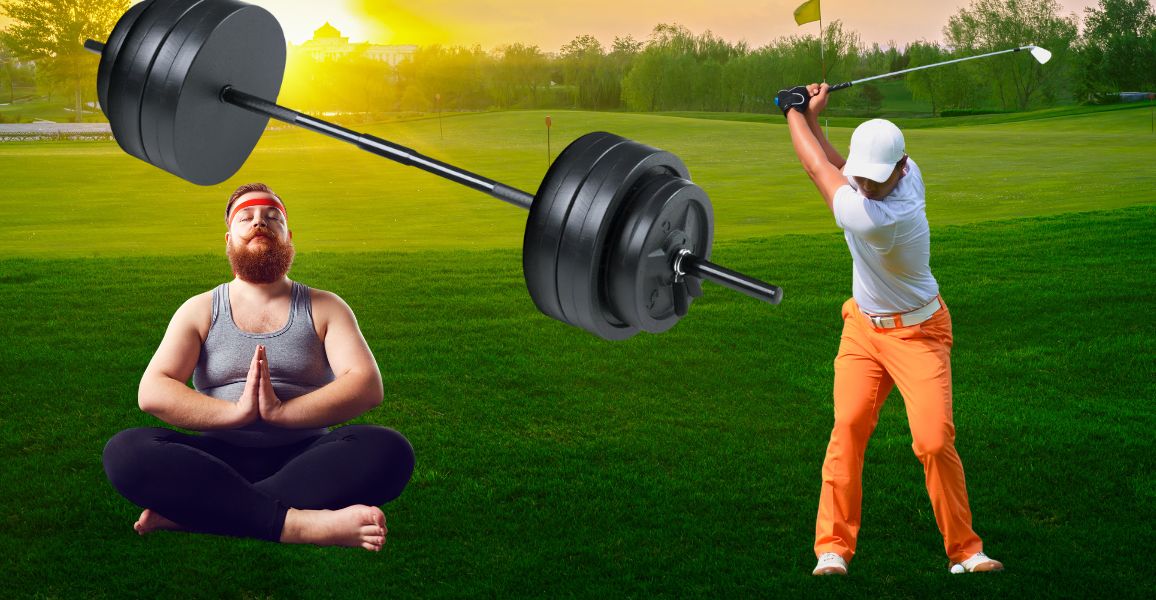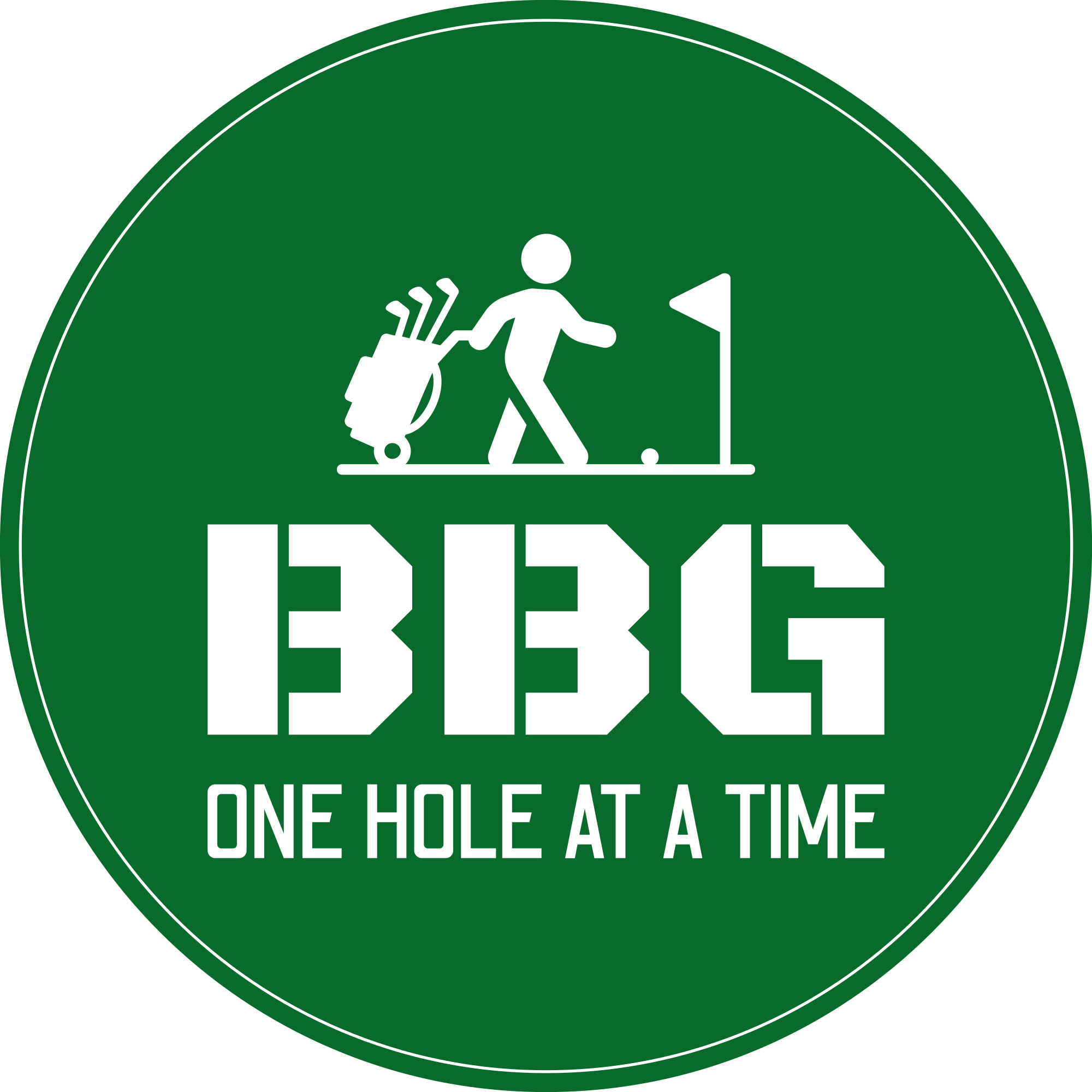Knee pain and golf go together like peanut butter and jelly, and pain in your lead leg is more common than in the trail leg.
A study was carried out which found that 18% of golfers have suffered from golf-related knee injuries at some point.
Since you’re reading this post, you must be a member of the rickety knee club, congratulations!
Throughout this post, we will mention the left knee a lot as most golfers are right-handed, so this will be their lead leg.
After all, right-handed golfers account for 93% of the golfers in America.
But if you’re a lefty, the same info applies, just obviously with your right knee instead.
By the end of this post, you will have all the information you need to reduce knee pain in the short term and be pain-free playing your best golf in the long term.
How Common Is Knee Pain In Golf?

Knee problems plague about 18% of golfers, while back injuries affect roughly 33%.
This stat shouldn’t be a surprise, but when it comes to golf related injuries, the lower back is the most common in golf.
Tiger Woods is the perfect example of the damage these two injuries can cause if not dealt with properly.
Woods has had to pull out of 7 tournaments due to knee and ankle injuries in his lead leg, he also withdrew from 4 due to back injuries.
Not to mention the countless number of operations that he’s undergone.
Some tests have shown that the force to your lead knee during your downswing is about four times your body weight.
Can You Play Golf With A Knee Injury?
The short answer is yes, you can. Nothing stops you from hitting the course with a knee injury, but you can agitate your knee and worsen it.
Playing on an already injured knee can turn what might have been a 1-2 week recovery into a month, two months, or worse recovery window.
For example, Tiger would continue to play with torn ACLs, amongst other injuries, instead of getting treatment.
Tiger did this as he would have missed out on tournaments in his earlier career.
It worked out for him in 2007, as he won five events after rupturing his ACL without surgery.
However, he then ended up missing the majority of 2008 with multiple surgeries on that left leg, which may not have been as severe if he rested the year prior.
Mmaybe he would still be playing his best golf today if he rested up.
But he’s playing for millions of dollars; you’re playing with your buddies, so rest up when you should.
Missing a couple of tee times is better than missing months on end.
Why Knee Pain Can Affect Your Game
No matter which of your knees is injured, it will affect your game of golf and could even make you withdraw from a round of golf.
When your lead knee injured, it will affect your downswing and follow-through, and the same for your trail knee on your backswing.
Either way, you won’t be able to shift your weight correctly, leading to less power and inconsistent shots on the course.
Not only will they affect your game physically, but mentally, playing with an injury can take you out of the headspace you need while playing golf.
Even walking a full 18 carrying or pushing your golf bag around will not be something you would enjoy.
No matter how you look at it, a knee injury will add strokes to your scorecard every time, which you don’t want if you’re trying to break 100, 90, or 80.
Playing With Knee Pain (Short-Term Fixes)

Rest
Rest shouldn’t be overlooked just because you refuse to miss your next tee time.
You could return to the golf course quickly with proper rest, which means staying away from anything that puts too much strain on your knee.
When you rest, you allow the inflammation in your knee to go down, and you start feeling better.
Pain Killers
Before taking painkillers, talking to a medical professional is always best.
For pain that is slight and hasn’t been a long-term issue, painkillers are a great way to help reduce pain and make day-to-day activities bearable.
If the pain is an issue you’ve been dealing with for a while, painkillers will be little help in the long run.
If this is you, then jump down to our long-term solutions to knee pain.
Gels, Sprays, Ice Packs… Frozen Peas
Gels and sprays can reduce pain and inflammation in the affected area.
Although they won’t be as effective as painkillers, they are essential to keep in your golf bag when preparing for a round.
Or you can’t go wrong with a good owl fashioned ice pack or frozen peas!
Playing With Knee Pain (Long-Term Fixes)

Improve Your Flexibility
Working on your overall flexibility is something every golfer needs if they want to play golf week after week with little to no injuries.
Tight and stiff muscles can restrict your golf swing and find themselves under more pressure than if they were loose, which causes injuries.
When it comes to avoiding knee injuries, you should focus on stretching out your hips and upper leg muscles in the same way you would do your back stretches before a round.
Improve Your Overall Strength
Weak muscles strain your knee joints, making them more likely to pick up injuries.
Stronger muscles will reduce the strain on your knee joint, which results in fewer injuries.
Your core and quads are the muscles you need to work on to prevent knee injuries.
Develop Stronger Quads
By having stronger quads, you will make it easier for yourself to shift your body weight throughout your whole golf swing.
You can start by doing bodyweight squats with your feet shoulder apart and try for four sets of 10-15 repetitions.
Also worth a try would be front or backward lunges, whichever you feel comfortable doing for the same reps and sets as the squats.
Access to gym equipment is a massive advantage as you can make the most of the various machines and weights.
Develop A Stronger Core
Some strong core muscles will benefit not only when it comes to knee pain but all other aspects of your golf game too.
Your core muscles get used on every swing you take, and if they are weak, they could lead to bad knees, back injuries, and even less distance with a golf ball.
Get started by trying some planks and situps at home, or try out the rowing machine in your local gym.
Work On Your Swing Mechanics
Turn You Lead Foot Outwards
Turning your lead foot outwards towards the target allows for better hip rotation more through impact, reducing the force on your knee.
For example, if you were to run full force into a locked door, you would bounce off and damage the door.
Now imagine you ran into that same door, but it was left slightly open, you would run through it with little to no damage to the door itself.
This is because the power could continue on its natural path, similar to your swing when the foot is angled outwards.
Right, that’s enough about doors!
You’re Too Tense
Being too tense throughout your golf swing; tight muscles restrict your natural movements and can lead to injuries.
When you’re loose and relaxed throughout your golf swing, the risk of injury drops considerably.
You’re Standing Up Too Straight
Not having a slight bend in your knees while you swing.
Swinging your golf club without bending your legs will seriously damage your knees.
Returning To Golf After A Knee Injury
In the worst-case scenario, if your knee injury was severe enough to rip you away from the golf course for a while, you want to take things slow.
Once you get the all-clear to play again, try going to the driving range first.
Get yourself a bucket of balls and hit some light shots. Don’t worry about doing a full golf swing for now.
Keep hitting balls, and remember to stop if you start feeling discomfort; if you have some golf balls left over, leave them for the next guy!
